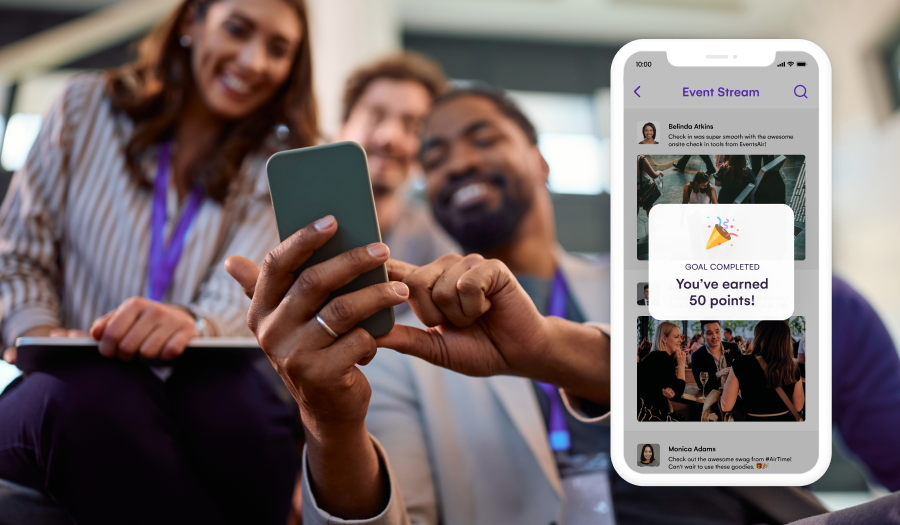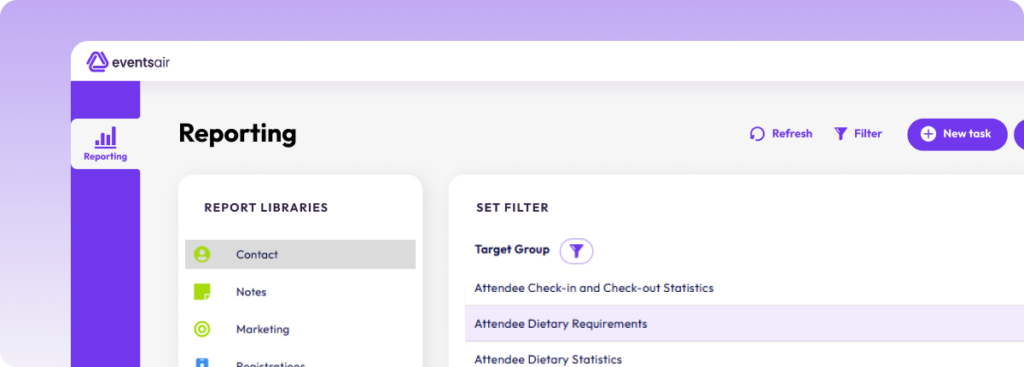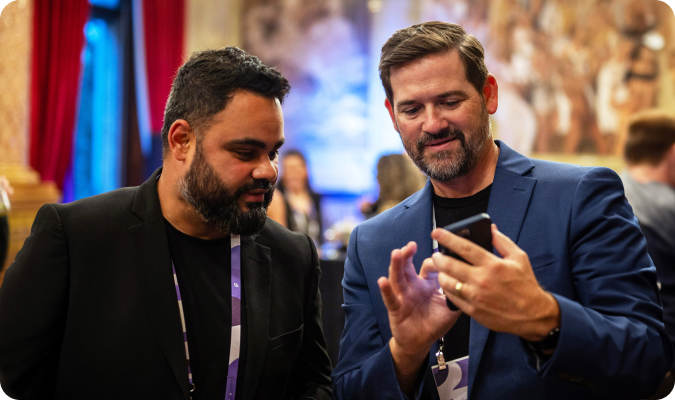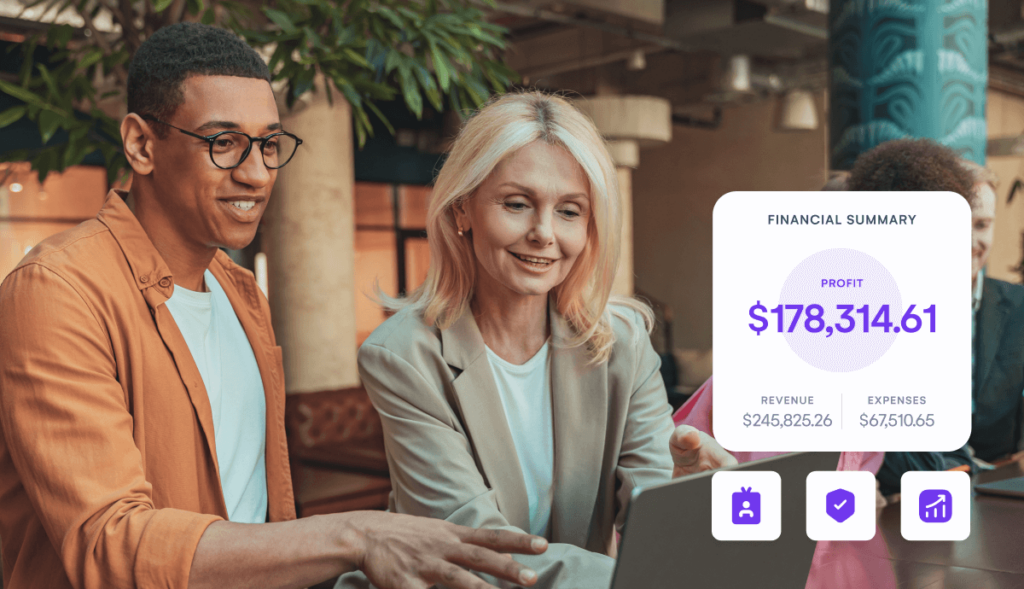
You’ve poured months into planning an event. The speakers are great, the content is solid, but when the day arrives, attendees are distracted, disengaged, and drifting toward the exit, or the “leave meeting” button.
Sound familiar? For corporate event planners, marketers, and associations, keeping attendees focused and interactive is one of the biggest challenges, especially in hybrid or virtual environments where distractions are just a click away.
In this EventsAir guide, we’ll explain what event gamification means, why it works, and how you can build engaging, interactive experiences that drive participation, learning, and connection.
What is event gamification?
Event gamification refers to the incorporation of game-like elements into an event to encourage participation, interaction, and engagement. It turns standard event activities into fun, rewarding experiences that encourage attendees to get involved. In fact, gamified event experiences see up to 48% more engagement compared to non-gamified ones.
Common elements of event gamification include:
- Points: Earned by completing actions like attending sessions or answering polls
- Badges: Virtual rewards for hitting goals or completing challenges
- Leaderboards: Rankings that show top participants
- Challenges or missions: Tasks that unlock content or rewards
- Progress tracking: Visual markers that show attendee progress
Why gamification matters for events
- Boost sponsor and exhibitor visibility: Create booth visit challenges or digital passports that drive traffic and increase sponsor value.
- Support learning and retention: Use quizzes and interactive tasks to reinforce key content and help attendees retain important information.
- Encourage team interaction: Run group missions, scavenger hunts, or team-based contests to build stronger connections.
- Generate better attendee insights: Track participant actions to understand interests, behavior patterns, and engagement levels. EventsAir’s analytics make this easy and actionable.
- Increase session participation: Reward attendees for joining and staying engaged in live sessions, panels, or workshops.
Tips for creating a successful gamification strategy
1. Define clear objectives
Start with clear goals. Gamification should support your event’s purpose, not distract from it. When your objectives are focused and measurable, your game elements can work harder for you.
Think about what matters most to your event:
- Boost session attendance
- Support networking and connection
- Drive sponsor and exhibitor visits
- Reinforce learning and retention
Your gamification should match these goals. For example, if sponsor traffic is key, set up challenges that reward booth visits. If learning is a priority, try quizzes after sessions.
Every gamification element should serve a purpose. Clear objectives help you build an experience that’s engaging, strategic, and effective.
2. Understand your audience
The best gamification speaks directly to your attendees. When you know what drives them, you can create experiences they’ll actually want to be part of.
Start by looking at:
- Demographics: Age, profession, experience level
- Psychographics: Interests, values, motivations
- Behavioral data: Past event participation, content engagement
Then tailor your approach according to your findings to meet your audience where they are. For example;
- Younger audiences might respond to fast-paced, competitive games.
- A corporate crowd might lean toward learning-focused challenges.
- Some attendees will want prizes; others just want to see their name on the leaderboard.
EventsAir’s flexible attendee engagement tools let you customize your game strategy to fit these different audience needs, ensuring stronger participation and richer data collection.

3. Select the right gamification strategies
For best results, your gamification strategies should fit your goals, your audience, and how your event is delivered. This is the only way to keep people engaged without pulling them away from the experience.
For in-person events, consider:
- Stamp cards or QR check-ins to reward booth visits
- Taking advantage of advanced attendee app features
- Live challenges like scavenger hunts (these can even be digital scavenger hunts!)
- On-site rewards like giveaways or exclusive merch
For virtual events, consider:
- In-platform quizzes and polls to keep attention
- Leaderboards that refresh in real time
- Interactive video or session-based tasks
For hybrid events, consider:
- Centralized platforms for both audience types
- Shared activities that connect in-person and remote attendees
- Rewards that work equally well across both formats
Additionally, you’ll want to match the strategy to your event type:
- Workshops and training: Use points and quizzes to reinforce key concepts
- Expos or trade shows: Drive booth visits with missions and check-ins
- Internal meetings: Encourage teamwork with group challenges and friendly competition
With EventsAir, you can also integrate engagement data with post-event analytics, giving you deeper insights into what strategies resonated most with your audience.

4. Make it feel like part of the event
Gamification works best when it feels like a natural part of the event, not something added on later. Every element should support your event’s goals and fit naturally into the attendee journey.
Here’s how you can achieve this:
- Tie it to key moments: Link game actions to things people are already doing, like checking into sessions, visiting sponsor booths, or attending networking breaks.
- Keep it simple: Avoid cluttering the experience with too many strategies. A few well-timed challenges are more effective than an overwhelming list.
- Match strategies to goals: Use leaderboards for competition, badges for recognition, and missions to guide movement and behavior across your event.
- Use the right tech: For virtual and hybrid events, place game elements inside your existing platforms, apps, dashboards, or digital hubs, to avoid fragmentation. For example, with the EventsAir Mobile App, you can embed gamification directly into attendee workflows.
- Make participation easy: Be clear about how to play, what actions earn points, and what rewards are available. The easier it is to engage, the more people will join in.
5. Communicate rules and incentives clearly
Even the best gamification strategy will fall flat if attendees don’t understand how it works. Clear, simple communication is key to getting people to join in and stay engaged.
Make sure attendees know:
- What actions earn points or rewards
- How to track their progress
- What prizes are available (if any)
How you do this can differ, depending on your event format:
- For onsite events: Use signage, quick reminders from staff, and app notifications
- For virtual events: Use in-platform alerts, emails, and message prompts
- For hybrid events: Combine both to ensure no one misses key info
Irrespective of event format, you can improve clarity by:
- Keeping instructions short and easy to follow
- Avoiding vague rules or unclear steps
- Providing real examples so attendees know exactly what to do
- Updating leaderboards and progress stats regularly
- Recognizing top performers throughout the event, not just at the end
To streamline this communication, tools like the EventsAir’s Alerts, News, and Posts keep attendees informed in real time, wherever they are. Whether it’s reminding them of new challenges, highlighting leaderboard updates, or announcing rewards, these features help ensure no one misses a beat.
6. Monitor engagement and gather feedback
Gamification doesn’t stop once it’s launched. To make it truly effective, you need to track its performance and gather feedback to improve future events.
Here’s how you can ensure effective monitoring:
- Use analytics to monitor key metrics. Insights, such as participation rates, task completion, and time spent on gamified activities, help you see what’s working and where adjustments may be needed.
- Collect feedback through post-event surveys. Ask attendees what they liked, what felt unclear, and what could be better. Their input gives you a clearer picture of the attendee experience.
- Leave no data out. For hybrid events, ensure that you capture data from both in-person and virtual participants.
By combining data and direct feedback, you can refine your gamification strategy, enhance future engagement, and more effectively align your efforts with event goals.
Real-world success stories in event gamification
Here are two real-world examples that demonstrate how event teams have successfully implemented gamification in different contexts using flexible event management platforms like EventsAir.
1. The Delegate Wranglers: Pre-event buzz and 75% gamification participation
The Delegate Wranglers (DW), a leading online community in the event industry, hosted their first “Nearly Christmas Party” in November 2023 with over 120 carefully vetted buyers and suppliers. Their goal was simple: create a fun, memorable experience that encouraged meaningful connections.
To build excitement and boost networking, DW introduced gamification early in the attendee journey. Right after registration, attendees joined a private Facebook group and took part in app-based challenges, quizzes, social media tasks, and other point-earning activities, that sparked friendly competition before the event.
The outcome was impressive:
- 50–75% of attendees engaged with gamification
- Leaderboards and real-time point tracking kept competition alive
- Prizes added extra motivation
Founder Neil Thompson said the approach “struck the perfect balance,” enhancing both social and networking aspects. By gamifying digital and live touchpoints, DW increased participation and created lasting buzz, even sparking FOMO among those who missed out.
2. Science and Technology Australia: Streamlined Engagement with Event Apps
Science and Technology Australia (STA) supports over 115,000 scientists and technologists across the country. Previously managing events with spreadsheets and manual processes, they faced growing challenges as their events expanded.
By adopting event apps and digital tools, STA improved engagement and attendee experience through:
- Real-time interaction via mobile devices
- On-demand access to event content and updates
- Interactive features like polls and challenges
- Seamless communication throughout the event
STA’s approach follows key principles: fostering engagement, encouraging interaction, and using feedback to enhance events. Event Manager Mitchell Piercy said these tools “revolutionized how we engage with our delegates.”
Boost engagement effortlessly with EventsAir’s gamification tools
Event gamification turns ordinary interactions into exciting, rewarding experiences that keep attendees engaged before, during, and after your event. This adds fun challenges, points, and leaderboards to create memorable moments that encourage participation and build stronger connections.
EventsAir supports your gamification strategy with powerful, easy-to-use features integrated directly into its all-in-one event management platform. From branded mobile apps to live polls, quizzes, and real-time leaderboards, EventsAir makes it simple to design, launch, and track gamified experiences that drive attendee engagement and deliver measurable results.
Ready to transform your events and boost engagement with gamification? Get started today with EventsAir.
Attendee Experience | Event Planning & Management
See EventsAir in action
Discover why 12,000+ event professionals trust EventsAir to deliver effortless events, every time.




